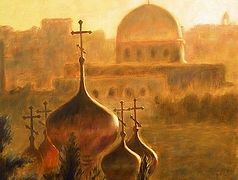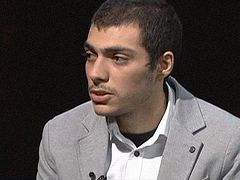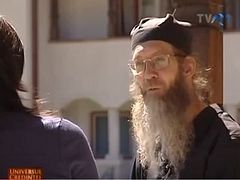Fr. Chiril is a German. Though he was born and grew up in Germany, he has lived at Radu Voda Monastery in Bucharest[1] for many years. He fell in love with Orthodoxy and Romania and decided to remain there forever, not as a layman but as a monk of one of the most famous monasteries in the capital.
The “unfair God”
The girl was only eight. He remembers this as clearly as if it happened yesterday. She had been infected with AIDS since birth, as is often the case in India where over two million adults live with this disease. She was to die just as her parents had died. She knew what awaited her, as did the nuns who were nursing her and the volunteers who worked in the orphanage. They were aware that they were unable to help her because this disease spares no one, even children. But despite her suffering and utter poverty the eight-year-old girl was happy and serene, while all the other patients around her despaired deeply.
“One day we all gathered around her bed and wept. She looked at us calmly: ‘Stop crying, I am going home!’ And in distress I felt as if my heart were breaking in my chest. Those words struck me! I was an eighteen-year-old guy, enchanted with Buddhism, but that encounter made me come face to face with the shocking scale of the human suffering. Feeling pity for the girl, I could find no solace in sorrow. ‘Why is there so much pain on this earth?’ I asked myself. ‘Why does God allow an innocent girl to die of an incurable disease? What has she done to deserve this?’
“From that moment on I was no longer satisfied with the Buddhists’ typical answer: ‘The girl suffered punishment in this life for some bad actions she had committed in her previous life according to karmic laws.’ I concluded that the God Who is only guided by the laws of karma must be merciless. So I gradually walked away from Buddhism and Hinduism and began to read the Bible again. It was only in Christianity, namely in Orthodox Christianity, that I found that God forgives us, that He Himself is love and mercy.
“That incident with the girl who eventually died in that orphanage became the turning point in my life.”
A house that was converted into a temple
 Little Niman with his father “Hare Krishna, Hare Krishna,
Little Niman with his father “Hare Krishna, Hare Krishna,
Krishna, Krishna, Hare, Hare,
Hare Rama, Hare Rama,
Rama, Rama, Hare, Hare!”
Before the sun had time to rise above the horizon the house of Herr Karthaus from the village of Argestorf near Hannover would be turned into a small Buddhist temple. The rite would begin at five in the morning. Herr Karthaus would repeat Maha-Mantra, trying to unite with Krishna by means of meditation.
This was the atmosphere little Niman (Fr. Chiril’s secular name) grew up in. His mother, a pious Protestant, would read the Bible and make bows in front of a crucifix and a statue of the Mother of God, while his father (who had converted to Hinduism in his youth and joined the Hare Krishna Movement) would read Bhagavad-Gita and sing mantras from the early morning.
“I grew up in Argestorf, and my parents still live there. It is a small village near Hannover. I had a wonderful childhood. I would play a lot in the open air and spend much time in the forest. I always sensed God’s presence. I would speak with Him right from my childhood; I would tell Him everything as if He were my friend. For me God was very real, but I remember having some kind of anxiety. I wanted to know Him better…
“Imagine, statues of Buddha, Krishna, and the Most Holy Theotokos stood in our house. Mom would read a Christian prayer before every meal, whereas dad would pray to Krishna every morning. Therefore, from that early age I wondered: which religion is true? Having this question in my mind, I looked intently at all the major religions but I didn’t feel that I found the truth.”
India
 As a volunteer in Paris When Niman turned sixteen, his father took him to India. He never imposed anything on his son, nor did he force him to choose some particular religion; rather, he tried to help him know them better. They visited ashrams and temples together, bowed before all the Hindu deities, danced in front of them, meditated, and prayed. But Niman didn’t feel satisfaction. Though India with all its colors, scents, and life filled with awe, did fascinate him, it nevertheless didn’t win his heart.
As a volunteer in Paris When Niman turned sixteen, his father took him to India. He never imposed anything on his son, nor did he force him to choose some particular religion; rather, he tried to help him know them better. They visited ashrams and temples together, bowed before all the Hindu deities, danced in front of them, meditated, and prayed. But Niman didn’t feel satisfaction. Though India with all its colors, scents, and life filled with awe, did fascinate him, it nevertheless didn’t win his heart.
At last they arrived in Dharamshala in north-western India (where the Tibetan diaspora in India lives) and had a meeting with the Dalai Lama there.
“I received the Dalai Lama’s blessing, but I didn’t ask him any questions. I felt drawn to Buddhism and decided that when I became mature enough I would go to a monastery to follow the spiritual path of Buddha Shakyamuni. But two years later an opportunity to do social work as a volunteer in India presented itself. I gladly agreed, hoping to study Buddhism more closely this way.
“I was eighteen and I wanted to do something specific for others and help them. In my naivety I even thought that I would be able to change the world, to turn it into something better and beautiful. But then there was the incident with the girl infected with HIV that I talked about above, so I was already unsure as to whether I really wanted to be a Buddhist monk. And I turned to Christianity again, started to read the Bible and pray. But it was thanks to Orthodoxy—to Romanian Orthodoxy, to be more exact—that I was to be completely transformed.”
A hymn to Jesus
 At the church of Radu Voda Monastery
At the church of Radu Voda Monastery
It all began when one day Jesus addressed him in an unusual hymn. It was sung to him by two Romanians in France. It was in the evening at one center, where the young people wanted to introduce those gathered there to the country they came from. All who had gathered there were public activists.
The Romanians chose a Church hymn, wishing to convey the spirit of their centuries-old tradition, the Romanian peasant faith, through it. Niman was spellbound as he listened to it. He had never heard anything of that kind before. The music was just so moving and deep.
That was his first encounter with Orthodoxy. At once he decided to go to Romania and find a volunteer position at some social center in Bucharest that worked with homeless children. Thus he ended up at a service at Radu Voda Monastery, where his soul cleaved to the beauty of Christ, which enters the world through icons, hymns, vestments, and ancient Byzantine services.
“The first service I attended was the Vespers. Although I couldn’t understand a word in Romanian, I was very impressed. I asked myself: ‘Maybe this is the truth? Maybe my search is over at last?’
“Now, when I tell Germans that Orthodox monastic services, especially during fasts, may last five to six hours, they are astonished and fail to understand how Orthodox manage to stand so long through the whole church service. But it doesn’t seem hard to me because I feel that Orthodox services are very dynamic and not static. At Lutheran or Roman Catholic services you just sit in your pew, like in a theater where you come to stay for a while and nothing else. But you have a special experience at Orthodox services, which have a great deal of life! We don’t look at the service as outsiders—we participate in them. Because this is what the Church is really like—the Church is not just a priest, or just monks, or just the choir that sings. No, we all make up the Church and participate in services by our prayers, bows and sometimes by singing.
“Byzantine icons are very conducive to the creation of this atmosphere. In Catholic churches icons are mainly regarded as works of art with no spiritual aspect; as for Lutherans, their icons were taken away from churches during the Reformation. Icons are always present in Orthodox churches as ‘windows to God’ that help us communicate with Him. After all, human beings need something tactile, and whenever we talk about God as about some abstract thing they find it hard to comprehend this. But when there is an icon in front of me, it helps me think about God, talk personally with Him, and have a specific relationship with Him.
“In my view, this accounts for the fact that in recent times icons have appeared in many Lutheran and Catholic churches. These people have longing for authenticity, genuineness, and search for Church origins as well. After all, icons existed from the first centuries of Christianity.”
The prayer of the heart[2]
—Was there a special occurrence, some special point when you firmly decided to choose Orthodoxy?
—After attending the first Vespers I mentioned above I had a desire to speak to a priest and learn more about Orthodoxy. And I met Fr. Polycarp here—we had talks with him and he guided me through my search. Having returned to Germany, I began to read the books Fr. Polycarp had recommended. It was then that I discovered St. Silouan of Mt. Athos, whose writings have also been translated into German; his love for the entire world touched my heart deeply.
 Archimandrite Polycarp (Chițulescu)
Archimandrite Polycarp (Chițulescu)
But the crucial point was when I read the book, The Way of a Pilgrim[3]--about an unnamed Russian monk who kept learning to perform the prayer of the heart. It had an enormous effect on me. I was astounded by the Jesus Prayer and began to perform it. I truly encountered the depths of Orthodoxy at that time. That experience has never been repeated again. This sweetness of the prayer of the heart, the never-ending joy of meeting Christ in the depths of my heart, a personal relationship with God which is only possible in Orthodoxy, particularly through the Jesus Prayer—all of this convinced me that it was the end of my search.
So I made up my mind to return to Romania to receive Orthodox Baptism and be absorbed into this prayer. Fr. Polycarp from Radu Voda Monastery told me to wait a little, prepare myself for this sacrament and read certain books. We kept in touch with him, and at some Point Fr. Polycarp invited me to the monastery for the Nativity of Christ, if I was really determined. This is precisely what happened! I came to spend my Christmas vacation there and was baptized into Orthodoxy at Radu Voda right on the feast of the Nativity. I was spiritually reborn on the very day that God was born on earth! After that I was tonsured at the same monastery.
“The Romanians are a humble nation”
—Fr. Chiril, why did you choose to live in Romania rather than one of other Orthodox countries? After all, there is also Mt. Athos—the motherland of a host of Orthodox monks.
—People often ask me this question: why I chose Romanian Orthodoxy (and not Greek or Russian—the latter two having a strong presence in Germany) and why I joined Radu Voda Monastery in Bucharest and not one of the Athonite lavras. I reply every time that it was natural for me. My first encounter with Orthodoxy was through Romanians and I was baptized here, at Radu Voda Monastery in Bucharest. Thus I developed a very intimate bond with Romania as a country and the Romanians as a nation.
And my impression is that there is something very humble, very genuine in Romanian Orthodoxy. Romanian churches—often so small and so humble—have nothing to do with megalomania. I don’t want to criticize other churches, but their spirit is different, while I adore this spirit of humility that can be found here, in Romania.
It is impossible to separate the Romanian people from the Church because the Church is nothing without people. And here both the church buildings and the people are very humble. Even when you study the history of Romania, you see that you are dealing with a meek, humble nation. And, as is generally known, humility is the principal Christian virtue, on which all the other virtues (which are completed in love) are based.
A bird that flies up to God
 The church of Radu Voda Monastery
The church of Radu Voda Monastery
—We are currently preparing for the Resurrection of the Savior[4]. Can you compare the preparation for Pascha in the Protestant Churches of Germany with the way they do it in Romania? Is there a significant difference?
—In the Lutheran Church, at least in my community, people hardly ever prepared for Pascha. Perhaps in the Catholic Bavaria they prepared for the Resurrection of Christ, but in a different way. People don’t observe fasts in the West anymore, and the sacrament of confession was abandoned in Protestantism—but these two things help us prepare for Pascha properly. Today Germany is a secular country and people perceive the Resurrection of the Savior just as a holiday with no special meaning: they take vacations, go to the country or have walks during this season.
In contrast to Germany, I feel that the whole of the Romanian nation prepares for this event of the Resurrection. During Lent the church of Radu Voda Monastery is packed with people—they come to confess their sins and fast, and they keep asking us what they should do to improve and grow closer to God. Different people--both young and old—come here, feeling the need to draw near to God.
During Lent we have services that I consider the most beautiful in the liturgical year. They give us an opportunity to sense our sinful state; and they don’t stop at this but show us how to rise up, how to become better, and I like this very much. In this period we monks try to fast more, pray more, and speak less—it is something that creates a wonderful atmosphere of expectation of Pascha and spiritual effort at the monastery.
—Waiting for Pascha, monks have the habit of observing a “black fast”[5]. Doesn’t it seem too severe to you? After all, Romanians acustom themselves to it from childhood.
—It is a fantastic experience of which I had known nothing before my conversion to Orthodoxy. It seems to me that when you keep the fasts you relieve yourself from this meaningless burden that you carry with you and feel like a flying bird, you feel much easier. Then it becomes much easier for you to lift up your mind to God as no burden weighs upon you anymore; because in essence we only come to the monastery to have a chance to focus on our relationship with God.
But we should take into account that fasting was established for us to help us and not vice versa. That is, we don’t keep fasts for the fast’s sake, but we do it so that this can help us in our path of drawing near to and meeting with Christ face to face. It is a kind of a combat weapon that God gave us so that we can win the war against our passions.
—Fr Chiril, in conclusion I would like to ask you if you have succeeded in finding an answer to the question that kept haunting you in Orthodoxy: why is there suffering in this world?
—I believe that there is suffering because God’s greatest gift to humanity is free will. But we don’t use our freedom to get to know God; rather, we use it to unbridle our passions. But God doesn’t want to violate our freedom. So, if we decide not to be with Him, He respects our free will. Thus, suffering exists because we humans choose it and spread it.
As for the innocent girl from India, I don’t know, I haven’t yet found an answer to the question as to why God allowed her to suffer so much and die. But I do know by my own experience that Christ, the Christian God, conquers justice by love, and I find this admirable. And though I fail to understand why that girl had to die, I believe one hundred percent in Divine love for her and for all of us humans, since I experienced this love in my heart.





